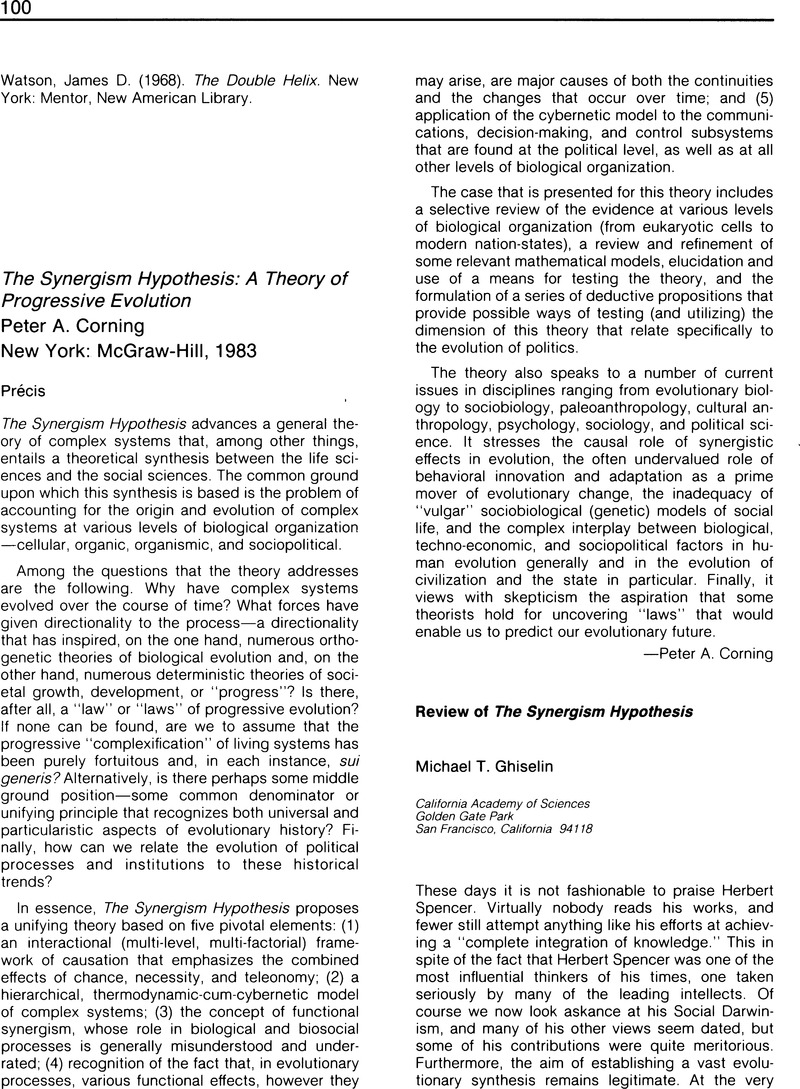No CrossRef data available.
Article contents
A Bootstrap Approach to Evolution: A Review of The Synergism Hypothesis
Published online by Cambridge University Press: 17 May 2016
Abstract
An abstract is not available for this content so a preview has been provided. Please use the Get access link above for information on how to access this content.

- Type
- Book Reviews
- Information
- Copyright
- Copyright © Association for Politics and the Life Sciences
References
Barkow, J. H. (1980). “Biological Evolution of Culturally Patterned Behavior.” In Lockard, J. S. (ed.), The Evolution of Human Social Behavior. New York: Elsevier.Google Scholar
Bronowski, J. (1974). “New Concepts in the Evolution of Complexity.” In Seeger, R. J. and Cohen, R. S. (eds.), Philosophical Foundations of Science. Dordrecht-Holland: D. Reidel.Google Scholar
Darwin, Charles (1859). The Origin of Species by Means of Natural Selection. New York: John B. Alden.Google Scholar
Dawkins, R. (1976). “Hierarchical Organization: A Candidate Principle for Ethology.” In Bateson, P. P. G. and Hinde, R. A. (eds.), Growing Points in Ethology. Cambridge: Cambridge University Press.Google Scholar
Dawkins, R. (1978). “Replicator Selection and the Extended Phenotype.” Zeitschrift für Tierpsychologie 47: 61–76.CrossRefGoogle ScholarPubMed
Dawkins, R. (1982). The Extended Phenotype: The Gene as the Unit of Selection. Oxford: W. H. Freeman.Google Scholar
Durham, W. H. (1976). “Resource Competition and Human Aggression, Part I: A Review of Primitive War.” Quarterly Review of Biology 51: 385–416.Google Scholar
Hamilton, W. D. (1964). “The Genetical Evolution of Social Behaviour, I and II.” Journal of Theoretical Biology 7: 1–32.Google Scholar
Lockard, J. S., ed. (1980). “Studies of Human Social Signals: Theory, Method and Data.” In Lockard, J. S. (ed.), The Evolution of Human Social Behavior. New York: Elsevier.Google Scholar
Schubert, G., and Somit, A., eds. (1982). The Biology of Primate Sociopolitical Behavior. DeKalb, Ill.: Program for Biosocial Research, Northern Illinois University.Google Scholar
Trivers, R. L. (1971). “The Evolution of Reciprocal Altruism.” Quarterly Review of Biology 46: 35–57.Google Scholar
Washburn, S. L., and Harding, R. S. (1970). “Evolution of Primate Behavior.” The Neurosciences. New York: Rockefeller University Press.Google Scholar
Williams, G. C. (1966). Adaptation and Natural Selection. Princeton, N.J.: Princeton University Press.Google Scholar
Wynne-Edwards, V. C. (1962). Animal Dispersion in Relation to Social Behaviour. Edinburgh: Oliver and Boyd.Google Scholar




